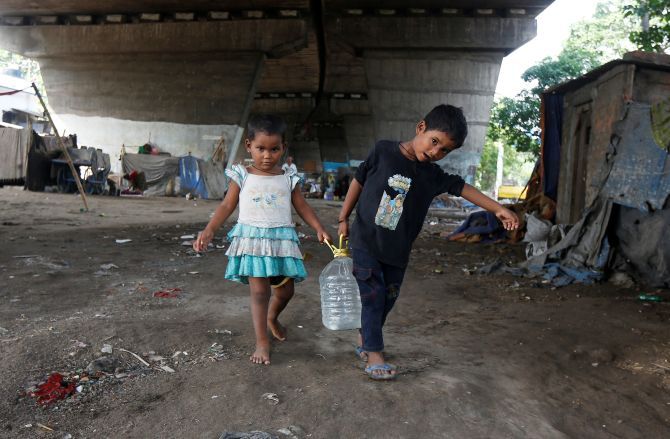The IMD has said temperatures in most parts of the country from March to May would be ‘above normal’. Sanjeeb Mukherjee reports.

The sudden rise in temperature across much of the north, central and western parts of the country in the last week of March heralded the arrival of summer and rattled everyone.
If the meteorological forecast is correct, this is just the beginning: April and May are expected to be hot and dry, and could lead to a severe water crisis.
"Barring a minor relief in the next three to four days, temperatures across most parts of the country would be above normal in April and May. There is unlikely to be any pre-monsoon activity over the next two months," said Mahesh Palawat, chief meteorologist at Skymet, a private weather forecasting firm.
The India Meteorological Department, too, in its summer forecast in February, had said temperatures in most parts of the country from March to May would be ‘above normal’.
About 16 states would experience a heat wave.
In a recent workshop on dealing with heat waves, the Met said May would be worse than April, with temperatures rising above 42°C in many places. Worse, the monsoon outlook for this year has inspired little confidence so far.
The IMD is expected to release the official monsoon forecast in mid-April. But, if forecasts of private agencies and some global models are considered, the rains this year could be less than average.
All this seems to signal a long, dry summer. This could have severe consequences for people, livestock and agriculture.
The levels in the 91-odd reservoirs across the country, which provide water for drinking and irrigation, have also started falling.
Between March 16 and 30, water levels in these reservoirs dropped by four percentage points, reaching 33 per cent of their full capacity.
The situation in reservoirs of the south is the worst, with water levels dropping fast.
Most experts believe as it gets hotter, water levels could shrink quicker than expected, triggering a crisis.
Prime Minister Narendra Modi, in a recent directive to all ministries and states, urged them to focus on water conservation projects under various schemes such as the Mahatma Gandhi National Rural Employment Generation Act and the Pradhan Mantri Krishi Sinchayee Yojana in the next three months.
Under the MGNREGA, the Centre had planned to build about 9,00,000 farm ponds across the country in 2016-17. Most of these were supposed to be built in drought-prone states such as Andhra Pradesh and Maharashtra.
"Drinking water is likely to be impacted first," Himanshu Thakkar, coordinator of South-Asia Network of Dams, Rivers and People, said.
The water crisis because of the heat wave and a prolonged summer is likely to be different in different parts of the country.
"Karnataka, Tamil Nadu, Kerala, Andhra Pradesh and Telangana are already suffering from drought. The summer might aggravate the condition. Elsewhere, too, rural areas seem more vulnerable to drinking water and other sorts of crisis," said Thakkar of South-Asia Network of Dams, Rivers and People.
He said the push towards building farm ponds and other conservation projects by the state and central governments was good.
However, a study of farm ponds in Maharashtra showed in many places people filled these with groundwater, without waiting for the rains to arrive. This defeated the entire exercise.
According to international water safety organisation Water Aid, India has the most number of rural people living without access to clean water -- 63.4 million. It ranked in the top 38 per cent of countries most vulnerable to climate change and least ready to adapt.
A report published by it also shows with 67 per cent of the population in rural areas and 7 per cent of the rural population living without access to clean water, the rural poor were highly vulnerable to the effects of extreme weather and climate change.
"If the summer is long and El Niño leads to a delay in monsoon, it could effect three major areas -- on agriculture in rain-fed areas; livestock in Andhra Pradesh, Rajasthan, Maharashtra and Karnataka; and the human population, as water demand will rise fast while replenishment of reservoirs, tanks and wells could take longer than usual," said Bharat Sharma, professor emeritus, International Water Management Institute.
The IMD, the National Disaster Management Authority, the Red Cross Society and the Medical Council of India have got into a mission mode to tackle the ill-effects of summer.
So far, most agriculturists have said the sudden rise in temperature has not had much impact on farming, except for late-sown varieties of wheat, pulses or mustard.
The bulk of the crop has already been harvested. However, if the summer is prolonged and the monsoon is late, this could have an impact on sowing patterns and maturity of crops, leading to lower yields.
"In some parts of western Uttar Pradesh, the standing wheat crop might be impacted because of the sudden rise in temperatures. 70-80 per cent of the crop in these parts is sown late. Besides this, the heat wave does not seem to have any impact on other rabi crops," a senior scientist said.
He said wheat was sown late -- around December last year -- in western UP, as most farmers were waiting to clear the sugarcane crop from their fields.
"If the high temperature continues for long, it might delay sowing of new sugarcane crops. No farmer would like to take the risk of crops withering," he said.
Photograph: Rupak De Chowdhuri/Reuters











